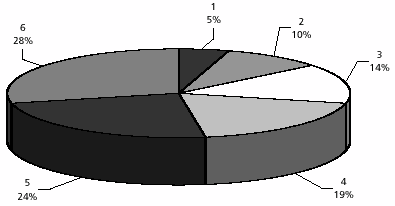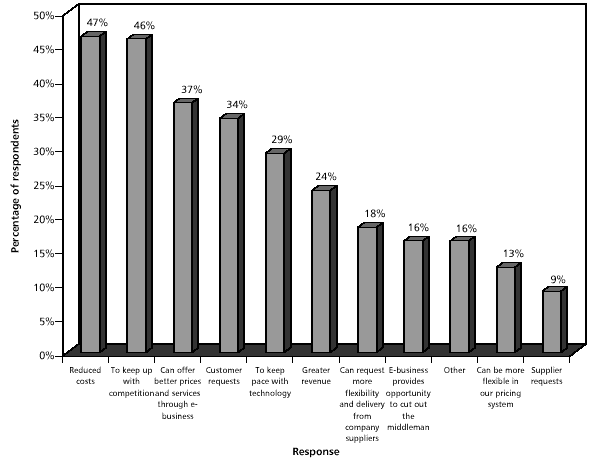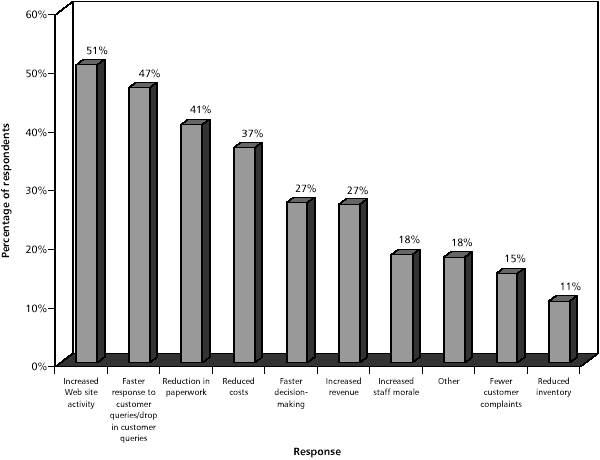 « Advisory Service Home | |||||
DAILY BUSINESS OPERATIONS BENEFIT FROM E-BUSINESSby Chris Pickering, Senior Consultant, Cutter ConsortiumRespondents to Cutter Consortium's latest Business-IT Strategies Survey, which focuses on e-business and IT alignment, tend to take a formal approach to IT in general and e-business in particular. This is reflected in the fact that 81% of respondents have a formal IT strategy, and 57% have a formal e-business strategy. Most respondents also feel that their IT and e-business strategies are well-aligned; as shown in Figure 1, 71% of respondents rate their alignment as good to excellent (4, 5, or 6).
Our survey results show efficiency and competition as the top factors driving e-business initiatives. Figure 2 summarizes these results. You can see that reduced costs and keeping up with competition essentially tied for top honors. Competitive pressures affect the next three entries as well: offering better prices and services through e-business, customer requests, and keeping pace with technology. Greater revenue takes the next spot, followed by establishing a better position with suppliers, eliminating the middleman, and other pricing and supplier-relationship advantages.
So, we have a group of respondents that tend to explicitly detail their IT and e-business plans through formal strategies, and we have a list of the driving factors behind their e-business initiatives. From this foundation, it is interesting to investigate the results they have achieved to see how well they match with the explicit drivers listed in Figure 2. MAPPING DRIVERS TO BENEFITSRespondents' realized advantages from e-business are shown in Figure 3. The first thing a comparison of Figures 2 and 3 shows is that reduced costs -- the most common driver -- are not the most common benefit. However, keeping up with the competition, the driver that essentially tied with reduced costs for the number one spot in Figure 2, is reflected in the top two entries in Figure 3: increased Web site activity and faster response to customer queries/drop in customer queries. The next entry, reduction in paperwork, should carry cost-saving benefits, and it's obvious which category entry 4, reduced costs, falls in. The final entry in Figure 3, reduced inventory, has obvious cost-saving effects. So it seems respondents have enjoyed some cost-saving benefits from e-business, but their results have probably fallen short of their expectations.
Increased revenue shows up in the middle of the benefits shown in Figure 3, approximately the same position it holds in Figure 2. Just less than one-fourth of respondents listed increased revenue as a driving force behind their e-business efforts, and slightly more than one-fourth listed it as a result. There appears to be a good match between expectations and results for those seeking increased revenue. It's difficult to map some of the driving forces in Figure 2 directly to the results in Figure 3. Nonetheless, some relationships can be suggested. The goals of offering better prices and services, more flexible prices, and cutting out the middleman from Figure 2 could be part of the picture behind increased revenue, for example. Faster decisionmaking improves competitive position. Implementing an e-business solution to customer requests (from Figure 2) should improve customer satisfaction, perhaps producing fewer customer complaints (in Figure 3). Implementing e-business in response to supplier requests and requesting more flexibility from suppliers should be part of the reason for reduced inventory. Some explicit objectives appear as direct and obvious benefits of e-business, and other objectives may be more camouflaged, appearing as part of a larger benefit or distributed across several benefits. This is particularly true of benefits that are primarily qualitative, such as increased staff morale. Keeping up with the competition, keeping pace with technology, and offering more flexible pricing may all result in better morale. But these same drivers may contribute to improved customer satisfaction and improved supplier satisfaction as well. CONCLUSIONSThe message here is to establish explicit objectives when possible and trace results to objectives as much as you can, but don't assume that all objectives will appear in discrete, concrete benefits or that all benefits will emanate obviously from objectives. E-business and its effects are too complex and subtle to be captured completely by simple analysis. In a parallel vein, e-business benefits don't have to be somehow esoteric to be worth pursuing. For example, it is often claimed (by myself and others) that the real power of e-business lies in reducing the friction of everyday business transactions. Survey results bear this out: cost savings, various examples of improved efficiency, and faster decisionmaking are all a result of reducing friction. There is nothing esoteric about this effect -- it comes from using e-business to enhance the execution of normal business activities -- but it is a benefit that is available to all e-business users. At this point in time, when many question the value of e-business -- and even its future viability -- these findings show that today's e-business users are achieving real benefits. The findings also suggest that the most likely place to look for e-business benefits is in our day-to-day business operations. ABOUT THE AUTHOR | |||||
Back to Top © 2002 Cutter Consortium. All rights reserved. Comments/suggestions to webmaster@cutter.com. |




